- Home
- H. P. Lovecraft
Transition of H. P. Lovecraft Page 35
Transition of H. P. Lovecraft Read online
Page 35
“Odd formations on slopes of highest mountains. Great low square blocks with exactly vertical sides, and rectangular lines of low, vertical ramparts, like the old Asian castles clinging to steep mountains in Roerich’s paintings. Impressive from distance. Flew close to some, and Carroll thought they were formed of smaller separate pieces, but that is probably weathering. Most edges crumbled and rounded off as if exposed to storms and climate changes for millions of years.
“Parts, especially upper parts, seem to be of lighter-colored rock than any visible strata on slopes proper, hence of evidently crystalline origin. Close flying shows many cave mouths, some unusually regular in outline, square or semicircular. You must come and investigate. Think I saw rampart squarely on top of one peak. Height seems about thirty thousand to thirty-five thousand feet. Am up twenty-one thousand, five hundred myself, in devilish, gnawing cold. Wind whistles and pipes through passes and in and out of caves, but no flying danger so far.”
From then on for another half hour Lake kept up a running fire of comment, and expressed his intention of climbing some of the peaks on foot. I replied that I would join him as soon as he could send a plane, and that Pabodie and I would work out the best gasoline plan—just where and how to concentrate our supply in view of the expedition’s altered character. Obviously, Lake’s boring operations, as well as his aeroplane activities, would require a great deal for the new base which he planned to establish at the foot of the mountains; and it was possible that the eastward flight might not be made, after all, this season. In connection with this business I called Captain Douglas and asked him to get as much as possible out of the ships and up the barrier with the single dog team we had left there. A direct route across the unknown region between Lake and McMurdo Sound was what we really ought to establish.
Lake called me later to say that he had decided to let the camp stay where Moulton’s plane had been forced down, and where repairs had already progressed somewhat. The ice sheet was very thin, with dark ground here and there visible, and he would sink some borings and blasts at that very point before making any sledge trips or climbing expeditions. He spoke of the ineffable majesty of the whole scene, and the queer state of his sensations at being in the lee of vast, silent pinnacles whose ranks shot up like a wall reaching the sky at the world’s rim. Atwood’s theodolite observations had placed the height of the five tallest peaks at from thirty thousand to thirty-four thousand feet. The windswept nature of the terrain clearly disturbed Lake, for it argued the occasional existence of prodigious gales, violent beyond anything we had so far encountered. His camp lay a little more than five miles from where the higher foothills rose abruptly. I could almost trace a note of subconscious alarm in his words—flashed across a glacial void of seven hundred miles—as he urged that we all hasten with the matter and get the strange, new region disposed of as soon as possible. He was about to rest now, after a continuous day’s work of almost unparalleled speed, strenuousness, and results.
In the morning I had a three-cornered wireless talk with Lake and Captain Douglas at their widely separated bases. It was agreed that one of Lake’s planes would come to my base for Pabodie, the five men, and myself, as well as for all the fuel it could carry. The rest of the fuel question, depending on our decision about an easterly trip, could wait for a few days, since Lake had enough for immediate camp heat and borings. Eventually the old southern base ought to be restocked, but if we postponed the easterly trip we would not use it till the next summer, and, meanwhile, Lake must send a plane to explore a direct route between his new mountains and McMurdo Sound.
Pabodie and I prepared to close our base for a short or long period, as the case might be. If we wintered in the antarctic we would probably fly straight from Lake’s base to the Arkham without returning to this spot. Some of our conical tents had already been reinforced by blocks of hard snow, and now we decided to complete the job of making a permanent village. Owing to a very liberal tent supply, Lake had with him all that his base would need, even after our arrival. I wirelessed that Pabodie and I would be ready for the northwestward move after one day’s work and one night’s rest.
Our labors, however, were not very steady after 4 P.M., for about that time Lake began sending in the most extraordinary and excited messages. His working day had started unpropitiously, since an aeroplane survey of the nearly-exposed rock surfaces showed an entire absence of those Archaean and primordial strata for which he was looking, and which formed so great a part of the colossal peaks that loomed up at a tantalizing distance from the camp. Most of the rocks glimpsed were apparently Jurassic and Comanchian sandstones and Permian and Triassic schists, with now and then a glossy black outcropping suggesting a hard and slaty coal. This rather discouraged Lake, whose plans all hinged on unearthing specimens more than five hundred million years older. It was clear to him that in order to recover the Archaean slate vein in which he had found the odd markings, he would have to make a long sledge trip from these foothills to the steep slopes of the gigantic mountains themselves.
He had resolved, nevertheless, to do some local boring as part of the expedition’s general program; hence he set up the drill and put five men to work with it while the rest finished settling the camp and repairing the damaged aeroplane. The softest visible rock—a sandstone about a quarter of a mile from the camp—had been chosen for the first sampling; and the drill made excellent progress without much supplementary blasting. It was about three hours afterward, following the first really heavy blast of the operation, that the shouting of the drill crew was heard; and that young Gedney—the acting foreman—rushed into the camp with the startling news.
They had struck a cave. Early in the boring the sandstone had given place to a vein of Comanchian limestone, full of minute fossil cephalopods, corals, echini, and spirifera, and with occasional suggestions of siliceous sponges and marine vertebrate bones—the latter probably of teleosts, sharks, and ganoids. This, in itself, was important enough, as affording the first vertebrate fossils the expedition had yet secured; but when shortly afterward the drill head dropped through the stratum into apparent vacancy, a wholly new and doubly intense wave of excitement spread among the excavators. A good-sized blast had laid open the subterrene secret; and now, through a jagged aperture perhaps five feet across and three feet thick, there yawned before the avid searchers a section of shallow limestone hollowing worn more than fifty million years ago by the trickling ground waters of a bygone tropic world.
The hollowed layer was not more than seven or eight feet deep but extended off indefinitely in all directions and had a fresh, slightly moving air which suggested its membership in an extensive subterranean system. Its roof and floor were abundantly equipped with large stalactites and stalagmites, some of which met in columnar form: but important above all else was the vast deposit of shells and bones, which in places nearly choked the passage. Washed down from unknown jungles of Mesozoic tree ferns and fungi, and forests of Tertiary cycads, fan palms, and primitive angiosperms, this osseous medley contained representatives of more Cretaceous, Eocene, and other animal species than the greatest paleontologist could have counted or classified in a year. Mollusks, crustacean armor, fishes, amphibians, reptiles, birds, and early mammals—great and small, known and unknown. No wonder Gedney ran back to the camp shouting, and no wonder everyone else dropped work and rushed headlong through the biting cold to where the tall derrick marked a new-found gateway to secrets of inner earth and vanished aeons.
When Lake had satisfied the first keen edge of his curiosity, he scribbled a message in his notebook and had young Moulton run back to the camp to dispatch it by wireless. This was my first word of the discovery, and it told of the identification of early shells, bones of ganoids and placoderms, remnants of labyrinthodonts and thecodonts, great mosasaur skull fragments, dinosaur vertebrae and armor plates, pterodactyl teeth and wing bones, Archaeopteryx debris, Miocene sharks’ teeth, primitive bird skulls, and other bones of archaic mammals such as pa
laeotheres, Xiphodons, Eohippi, Oreodons, and titanotheres. There was nothing as recent as a mastodon, elephant, true camel, deer, or bovine animal; hence Lake concluded that the last deposits had occurred during the Oligocene Age, and that the hollowed stratum had lain in its present dried, dead, and inaccessible state for at least thirty million years.
On the other hand, the prevalence of very early life forms was singular in the highest degree. Though the limestone formation was, on the evidence of such typical imbedded fossils as ventriculites, positively and unmistakably Comanchian and not a particle earlier, the free fragments in the hollow space included a surprising proportion from organisms hitherto considered as peculiar to far older periods—even rudimentary fishes, mollusks, and corals as remote as the Silurian or Ordovician. The inevitable inference was that in this part of the world there had been a remarkable and unique degree of continuity between the life of over three hundred million years ago and that of only thirty million years ago. How far this continuity had extended beyond the Oligocene Age when the cavern was closed was of course past all speculation. In any event, the coming of the frightful ice in the Pleistocene some five hundred thousand years ago—a mere yesterday as compared with the age of this cavity—must have put an end to any of the primal forms which had locally managed to outlive their common terms.
Lake was not content to let his first message stand, but had another bulletin written and dispatched across the snow to the camp before Moulton could get back. After that Moulton stayed at the wireless in one of the planes, transmitting to me—and to the Arkham for relaying to the outside world—the frequent postscripts which Lake sent him by a succession of messengers. Those who followed the newspapers will remember the excitement created among men of science by that afternoon’s reports—reports which have finally led, after all these years, to the organization of that very Starkweather-Moore Expedition which I am so anxious to dissuade from its purposes. I had better give the messages literally as Lake sent them, and as our base operator McTighe translated them from the pencil shorthand:
“Fowler makes discovery of highest importance in sandstone and limestone fragments from blasts. Several distinct triangular striated prints like those in Archaean slate, proving that source survived from over six hundred million years ago to Comanchian times without more than moderate morphological changes and decrease in average size, Comanchian prints apparently more primitive or decadent, if anything, than older ones. Emphasize importance of discovery in press. Will mean to biology what Einstein has meant to mathematics and physics. Joins up with my previous work and amplifies conclusions.
“Appears to indicate, as I suspected, that earth has seen whole cycle or cycles of organic life before known one that begins with Archaeozoic cells. Was evolved and specialized not later than a thousand million years ago, when planet was young and recently uninhabitable for any life forms or normal protoplasmic structure. Question arises when, where, and how development took place.”
“Later. Examining certain skeletal fragments of large land and marine saurians and primitive mammals, find singular local wounds or injuries to bony structure not attributable to any known predatory or carnivorous animal of any period, of two sorts—straight, penetrant bores, and apparently hacking incisions. One or two cases of cleanly severed bones. Not many specimens affected. Am sending to camp for electric torches. Will extend search area underground by hacking away stalactites.”
“Still later. Have found peculiar soapstone fragment about six inches across and an inch and a half thick, wholly unlike any visible local formation—greenish, but no evidences to place its period. Has curious smoothness and regularity. Shaped like five-pointed star with tips broken off, and signs of other cleavage at inward angles and in center of surface. Small, smooth depression in center of unbroken surface. Arouses much curiosity as to source and weathering. Probably some freak of water action. Carroll, with magnifier, thinks he can make out additional markings of geologic significance. Groups of tiny dots in regular patterns. Dogs growing uneasy as we work, and seem to hate this soapstone. Must see if it has any peculiar odor. Will report again when Mills gets back with light and we start on underground area.”
“10:15 P.M. Important discovery. Orrendorf and Watkins, working underground at 9:45 with light, found monstrous barrel-shaped fossil of wholly unknown nature; probably vegetable unless overgrown specimen of unknown marine radiata. Tissue evidently preserved by mineral salts. Tough as leather, but astonishing flexibility retained in places. Marks of broken-off parts at ends and around sides. Six feet end to end, three and five-tenths feet central diameter, tapering to one foot at each end. Like a barrel with five bulging ridges in place of staves. Lateral breakages, as of thinnish stalks, are at equator in middle of these ridges. In furrows between ridges are curious growths—combs or wings that fold up and spread out like fans. All greatly damaged but one, which gives almost seven-foot wing spread. Arrangement reminds one of certain monsters of primal myth, especially fabled Elder Things in Necronomicon.
“Their wings seem to be membranous, stretched on frame work of glandular tubing. Apparent minute orifices in frame tubing at wing tips. Ends of body shriveled, giving no clue to interior or to what has been broken off there. Must dissect when we get back to camp. Can’t decide whether vegetable or animal. Many features obviously of almost incredible primitiveness. Have set all hands cutting stalactites and looking for further specimens. Additional scarred bones found, but these must wait. Having trouble with dogs. They can’t endure the new specimen, and would probably tear it to pieces if we didn’t keep it at a distance from them.”
“11:30 P.M. Attention, Dyer, Pabodie, Douglas. Matter of highest—I might say transcendent—importance. Arkham must relay to Kingsport Head Station at once. Strange barrel growth is the Archaean thing that left prints in rocks. Mills, Boudreau, and Fowler discover cluster of thirteen more at underground point forty feet from aperture. Mixed with curiously rounded and configured soapstone fragments smaller than one previously found—star-shaped, but no marks of breakage except at some of the points.
“Of organic specimens, eight apparently perfect, with all appendages. Have brought all to surface, leading off dogs to distance. They cannot stand the things. Give close attention to description and repeat back for accuracy. Papers must get this right.
“Objects are eight feet long all over. Six-foot, five-ridged barrel torso three and five-tenths feet central diameter, one foot end diameters. Dark gray, flexible, and infinitely tough. Seven-foot membranous wings of same color, found folded, spread out of furrows between ridges. Wing framework tubular or glandular, of lighter gray, with orifices at wing tips. Spread wings have serrated edge. Around equator, one at central apex of each of the five vertical, stave-like ridges are five systems of light gray flexible arms or tentacles found tightly folded to torso but expansible to maximum length of over three feet. Like arms of primitive crinoid. Single stalks three inches diameter branch after six inches into five substalks, each of which branches after eight inches into small, tapering tentacles or tendrils, giving each stalk a total of twenty-five tentacles.
“At top of torso blunt, bulbous neck of lighter gray, with gilllike suggestions, holds yellowish five-pointed starfish-shaped apparent head covered with three-inch wiry cilia of various prismatic colors.
“Head thick and puffy, about two feet point to point, with three-inch flexible yellowish tubes projecting from each point. Slit in exact center of top probably breathing aperture. At end of each tube is spherical expansion where yellowish membrane rolls back on handling to reveal glassy, red-irised globe, evidently an eye.
“Five slightly longer reddish tubes start from inner angles of starfish-shaped head and end in saclike swellings of same color which, upon pressure, open to bell-shaped orifices two inches maximum diameter and lined with sharp, white toothlike projections—probably mouths. All these tubes, cilia, and points of starfish head, found folded tightly down; tubes and points clinging to bulbous neck and
torso. Flexibility surprising despite vast toughness.
“At bottom of torso, rough but dissimilarly functioning counterparts of head arrangements exist. Bulbous light-gray pseudoneck, without gill suggestions, holds greenish five-pointed starfish arrangement.
“Tough, muscular arms four feet long and tapering from seven inches diameter at base to about two and five-tenths at point. To each point is attached small end of a greenish five-veined membranous triangle eight inches long and six wide at farther end. This is the paddle, fin, or pseudofoot which has made prints in rocks from a thousand million to fifty or sixty million years old.
“From inner angles of starfish arrangement project two-foot reddish tubes tapering from three inches diameter at base to one at tip. Orifices at tips. All these parts infinitely tough and leathery, but extremely flexible. Four-foot arms with paddles undoubtedly used for locomotion of some sort, marine or otherwise. When moved, display suggestions of exaggerated muscularity. As found, all these projections tightly folded over pseudoneck and end of torso, corresponding to projections at other end.
“Cannot yet assign positively to animal or vegetable kingdom, but odds now favor animal. Probably represents incredibly advanced evolution of radiata without loss of certain primitive features. Echinoderm resemblances unmistakable despite local contradictory evidences.
“Wing structure puzzles in view of probable marine habitat, but may have use in water navigation. Symmetry is curiously vegetablelike, suggesting vegetable’s essential up-and-down structure rather than animal’s fore-and-aft structure. Fabulously early date of evolution, preceding even simplest Archaean protozoa hitherto known, baffles all conjecture as to origin.

 The Best of H.P. Lovecraft
The Best of H.P. Lovecraft The Definitive H.P. Lovecraft: 67 Tales Of Horror In One Volume
The Definitive H.P. Lovecraft: 67 Tales Of Horror In One Volume The Complete Works of H.P. Lovecraft
The Complete Works of H.P. Lovecraft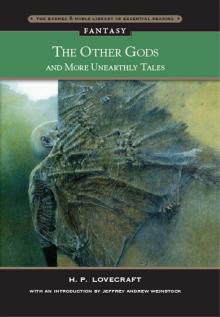 Other Gods and More Unearthly Tales
Other Gods and More Unearthly Tales Lovecraft's Fiction Volume I, 1905-1925
Lovecraft's Fiction Volume I, 1905-1925 The Shadow Out of Time
The Shadow Out of Time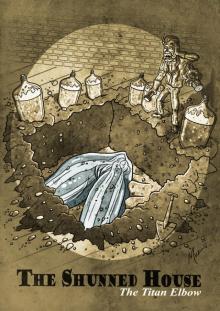 The Shunned House
The Shunned House Lovecraft's Fiction Volume II, 1926-1928
Lovecraft's Fiction Volume II, 1926-1928 The Thing on the Doorstep and Other Weird Stories
The Thing on the Doorstep and Other Weird Stories Dream Cycle of H. P. Lovecraft: Dreams of Terror and Death
Dream Cycle of H. P. Lovecraft: Dreams of Terror and Death Great Tales of Horror
Great Tales of Horror Shadows of Death
Shadows of Death Delphi Complete Works of H. P. Lovecraft (Illustrated)
Delphi Complete Works of H. P. Lovecraft (Illustrated) Waking Up Screaming: Haunting Tales of Terror
Waking Up Screaming: Haunting Tales of Terror H.P. Lovecraft Goes to the Movies
H.P. Lovecraft Goes to the Movies The Road to Madness
The Road to Madness The Complete H.P. Lovecraft Reader (68 Stories)
The Complete H.P. Lovecraft Reader (68 Stories) The Horror in the Museum
The Horror in the Museum Collected Fiction Volume 1 (1905-1925): A Variorum Edition
Collected Fiction Volume 1 (1905-1925): A Variorum Edition Lovecrafts_Fiction, vol.I_1905-1925
Lovecrafts_Fiction, vol.I_1905-1925 Writings in the United Amateur, 1915-1922
Writings in the United Amateur, 1915-1922 H.P. Lovecraft: The Complete Works
H.P. Lovecraft: The Complete Works Collected Fiction Volume 3 (1931-1936): A Variorum Edition
Collected Fiction Volume 3 (1931-1936): A Variorum Edition H.P. Lovecraft: The Complete Fiction
H.P. Lovecraft: The Complete Fiction Collected Fiction Volume 2 (1926-1930): A Variorum Edition
Collected Fiction Volume 2 (1926-1930): A Variorum Edition Yog Sothothery - The Definitive H.P. Lovecraft Anthology
Yog Sothothery - The Definitive H.P. Lovecraft Anthology The Complete H.P. Lovecraft Collection (Xist Classics)
The Complete H.P. Lovecraft Collection (Xist Classics) The Watchers Out of Time
The Watchers Out of Time Eldritch Tales
Eldritch Tales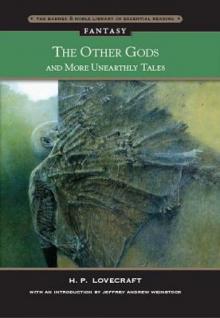 The Other Gods And More Unearthly Tales
The Other Gods And More Unearthly Tales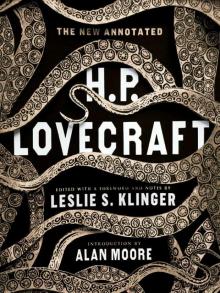 The New Annotated H. P. Lovecraft
The New Annotated H. P. Lovecraft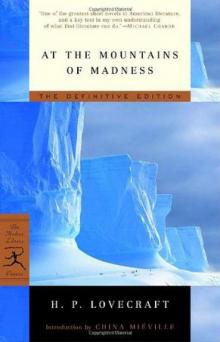 At the mountains of madness
At the mountains of madness Bloodcurdling Tales of Horror and the Macabre
Bloodcurdling Tales of Horror and the Macabre Fossil Lake II: The Refossiling
Fossil Lake II: The Refossiling Shadows of Carcosa: Tales of Cosmic Horror by Lovecraft, Chambers, Machen, Poe, and Other Masters of the Weird
Shadows of Carcosa: Tales of Cosmic Horror by Lovecraft, Chambers, Machen, Poe, and Other Masters of the Weird H. P. Lovecraft
H. P. Lovecraft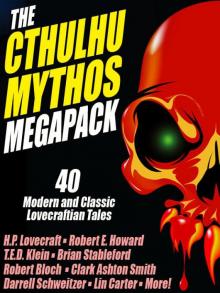 The Cthulhu Mythos Megapack
The Cthulhu Mythos Megapack The Complete H. P. Lovecraft Reader (2nd Edition)
The Complete H. P. Lovecraft Reader (2nd Edition) The Complete Fiction
The Complete Fiction Waking Up Screaming
Waking Up Screaming Transition of H. P. Lovecraft
Transition of H. P. Lovecraft![[1935] The Shadow Out of Time Read online](http://i1.bookreadfree.com/i2/04/12/1935_the_shadow_out_of_time_preview.jpg) [1935] The Shadow Out of Time
[1935] The Shadow Out of Time The Horror Megapack
The Horror Megapack